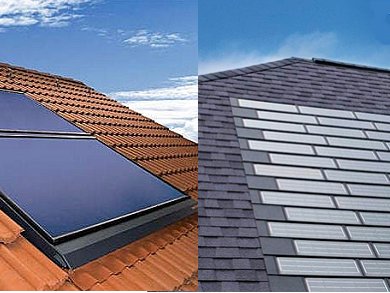Solar Sustainability: Finding Replacements for Rare Earth Metals
For many parts of the world there is a lot of sunlight around, even in rainy old England there’s a silvery lining on many a cloud. Unfortunately, photovoltaic panels that convert sunlight into electrical energy (pictured, left) rely on expensive crystalline semiconductor materials. Speaking at the 244th National Meeting of the American Chemical Society (ACS), however, Harry Atwater explained how he and his colleagues are hoping to side-step many of the issues with those materials by turning to far more readily available and malleable metals, including zinc and copper, as alternatives to the likes of germanium.
Atwater’s team at The California Institute of Technology (Caltech), Pasadena, California, USA, suggest that enough sunlight hits domestic roofs across the USA that it could be used to supply at least half of America’s electricity demands. A similar equation can be undertaken in other countries. The urgency now is to find inexpensive and yet efficient alternatives to conventional photovoltaic materials that could be used as electricity-generating shingles in newly built properties rather than panels stacked on top of the roofs of old buildings.
In discussing solar sustainability, Atwater highlights one of the most pressing issues regarding the materials needed for photovoltaics, namely that the standard semiconductors, silica aside, are not very accessible in the West. Indeed, there is a need to find “earth-abundant” materials for photovoltaics that could be incorporated into construction materials because, unfortunately, the indium and gallium being investigated experimentally are found in relatively large and mineable deposits only in China.
Earth-Abundant Materials Show their Potential
“Sustainability involves developing technology that can be productive over the long-term, using resources in ways that meet today’s needs without jeopardizing the ability of future generations to meet their needs,” Atwater says. New photovoltaic technologies could exploit copper and zinc instead of the rare earth elements, 90 % of which are currently supplied from China for use in the batteries for hybrid cars, magnets, electronics, and other high-tech products.
Atwater and his colleague, Dow Chemical’s James Stevens, described successful efforts to replace rare earths and other costly metals in their photovoltaic devices with other metals. They have developed and tested new devices using zinc phosphide and copper oxide, which they claim have broken records for both electrical current and voltage achieved by existing with other thin-film solar energy conversion devices using those metals.
“The United States alone has about 69 billion square feet of appropriate residential rooftops that could be generating electricity from the sun,” Stevens explains. “The sunlight falling on those roofs could generate at least 50 % of the nation’s electricity, and some estimates put that number closer to 100 %. With earth-abundant technology, that energy could be harvested, at an enormous benefit to consumers and the environment.”
They point out that the fundamental properties of the alternative materials with which they are working are promising, although not yet as efficient as conventional semiconductor solar materials, Atwater says. His team have produced prototype cells based on zinc phosphide that are up to about 6 % efficient. However, their tests show that the open-circuit voltages are higher than those possible with conventional semiconductor solar cells. Atwater says this bodes well for the ultimate development of more efficient devices that sidestep conventional semiconductor materials.
So far they have been successful in synthesizing a quasi-single crystal of zinc phosphide using physical vapor transport. They are also now experimenting with different surface-processing methods to prevent degradation and looking at ways of combining this material with magnesium to form diode type devices.
High Voltage Not Enough
Atwater points out that high voltage is not enough for a viable technology: this has to be matched by high current too, given that power is a product of ampage and voltage. They are currently striving to find ways to extract as many amps as possible from their material at the high voltage available.
The researchers are also looking at copper oxide and iron sulfide as abundantly available materials for future photovoltaics. The work suggests that these two materials might very well be capable of the very high efficiencies required of viable solar energy conversion, in the medium term. Atwater suggests that the cost will fall below that of producing the equivalent amount of electrical power from a coal-fired power plant within a couple of decades.
Stevens was part of the team that helped develop Dow’s PowerHouse Solar Shingle (pictured, right), which was introduced in October 2011. These shingles are installed in the same way as conventional roofing tiles but use copper indium gallium diselenide photovoltaic technology to endow them with solar energy conversion abilities. The researchers are now investigating how that material might be swapped for sustainable earth-abundant compounds.
- Presented at the 244th ACS National Meeting & Exposition in Philadelphia, USA, August 19–23, 2012.


